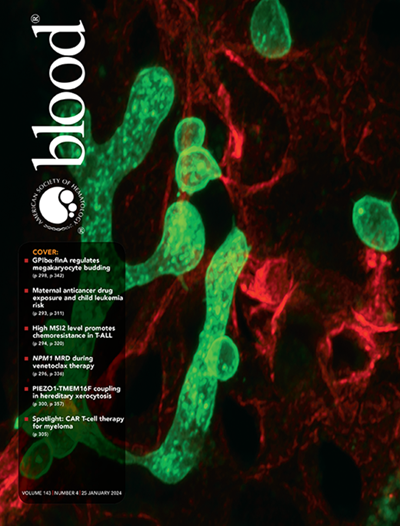促凝和中性粒细胞来源的抗凝蛋白在c1q - net驱动的血液凝固中的相互作用。
IF 23.1
1区 医学
Q1 HEMATOLOGY
引用次数: 0
摘要
中性粒细胞与组织和血液微环境中的外部环境相互作用,并逐渐成为血液凝固的重要调节因子1-3。在这项研究中,我们探讨了补体是否诱导中性粒细胞胞外陷阱(NET)的形成和相关的血液凝固使用人类供体来源的中性粒细胞。补体C1q诱导脂多糖(LPS) O127引物中性粒细胞NETosis,而LPS单独不诱导NETosis。大量RNA测序揭示了一种独特的lps驱动的中性粒细胞状态改变,并且发现NETosis的补体敏感性是转录依赖的。在中性粒细胞样分化的HL60细胞(dHL60)中使用排列CRISPR敲除筛选,我们发现了C1q-NETosis需要SCARF1和补体受体3。由于NETs含有促凝成分,如DNA和组蛋白,我们研究了c1q相关的NETs是否影响血液凝固。与单独LPS治疗相比,LPS+ C1q NETs与凝血活性降低相关。我们进一步发现,LPS上调中性粒细胞的组织因子表达和凝固相关活性。此外,在c1q介导的NET形成过程中,中性粒细胞分泌抗凝血蛋白,包括蛋白C和组织因子途径抑制剂,功能调节NET相关的凝血。C1q- NETs还能激活凝血因子FXII和FXI,促进内源性凝血和钾化钾素依赖性缓激肽的产生。本研究阐明了NETs如何调节促凝和抗凝成分,这些成分可能影响疾病的病理生理。本文章由计算机程序翻译,如有差异,请以英文原文为准。
Interplay of procoagulatory and neutrophil-derived anticoagulatory proteins in C1q-NET-driven blood coagulation.
Neutrophils interact with the external milieu in both tissue and blood microenvironments and are emerging as important regulators of blood coagulation 1-3. In this study, we explored whether complement induces Neutrophil Extracellular Trap (NET) formation and related blood coagulation using human donor-derived neutrophils. Complement C1q induces NETosis in Lipopolysaccharide (LPS) O127 primed neutrophils, while LPS alone does not induce NETosis. Bulk RNA sequencing revealed a unique LPS-driven altered neutrophil state and complement sensitivity for NETosis was found to be transcriptionally- dependent. Using an arrayed CRISPR Knockout screen in the neutrophil-like differentiated HL60 cells (dHL60), we identified that SCARF1 and Complement Receptor 3 are required for C1q-NETosis. Since NETs contain pro-coagulatory components such as DNA and histones, we investigated whether C1q-related NETs influenced blood coagulation. LPS+ C1q NETs were associated with reduced coagulation activity compared to LPS treatment alone. We further found that LPS upregulated Tissue Factor expression and coagulation-related activity in neutrophils. Furthermore, neutrophils secrete anticoagulant proteins, including Protein C and Tissue Factor Pathway Inhibitors, during C1q-mediated NET formation that functionally regulates NET-related coagulation. C1q- NETs also activate the coagulation factors FXII and FXI, facilitating both intrinsic coagulation and kallikrein-dependent bradykinin production. This study elucidates how NETs regulate both pro-coagulatory and anti-coagulatory components that may influence pathophysiology of disease.
求助全文
通过发布文献求助,成功后即可免费获取论文全文。
去求助
来源期刊

Blood
医学-血液学
CiteScore
23.60
自引率
3.90%
发文量
955
审稿时长
1 months
期刊介绍:
Blood, the official journal of the American Society of Hematology, published online and in print, provides an international forum for the publication of original articles describing basic laboratory, translational, and clinical investigations in hematology. Primary research articles will be published under the following scientific categories: Clinical Trials and Observations; Gene Therapy; Hematopoiesis and Stem Cells; Immunobiology and Immunotherapy scope; Myeloid Neoplasia; Lymphoid Neoplasia; Phagocytes, Granulocytes and Myelopoiesis; Platelets and Thrombopoiesis; Red Cells, Iron and Erythropoiesis; Thrombosis and Hemostasis; Transfusion Medicine; Transplantation; and Vascular Biology. Papers can be listed under more than one category as appropriate.
 求助内容:
求助内容: 应助结果提醒方式:
应助结果提醒方式:


